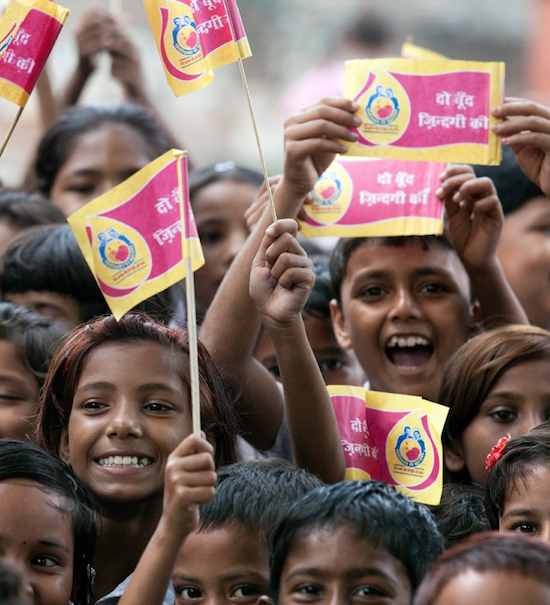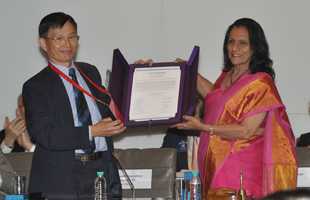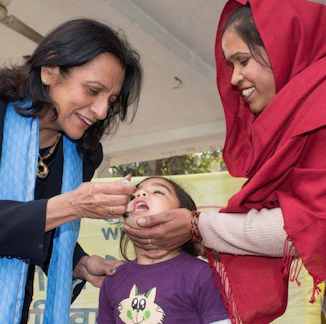 Older Americans remember when, in the 1940s and 50’s, polio crippled about 35,000 people each year. After Jonas Salk developed the polio vaccine, the devastating disease, which is caused by a virus and usually spreads via infected food or water, was eradicated in the US. In fact, over the last half century, polio has been eliminated in a majority of the world.
Older Americans remember when, in the 1940s and 50’s, polio crippled about 35,000 people each year. After Jonas Salk developed the polio vaccine, the devastating disease, which is caused by a virus and usually spreads via infected food or water, was eradicated in the US. In fact, over the last half century, polio has been eliminated in a majority of the world.
But in 1988, a collaboration of organizations — UNICEF, Rotary International, The U.S. Centers for Disease Control, and the World Health Organization (WHO) — formed the Global Polio Eradication Initiative, to promote vaccinations that will, once and for all, eradicate polio from the Earth.
They thought India would be the greatest challenge because historically it was the largest reservoir of the disease with up to 100,000 paralytic polio cases occurring each year between 1978 and 1995. It has also been one of the main sources of polio importation for other countries.
But today leaders of the monumental effort formally announced the end of polio in India. Further, they proclaimed the entire Southeast Asian region, home to a quarter of the world’s population, to be entirely polio-free.
Certified by an independent commission under the WHO certification process, it is the fourth of six WHO Regions to have achieved it. With this step, 80% of the world’s population now lives in certified polio-free regions.
An independent panel of 11 experts in public health, epidemiology, virology, clinical medicine and related specialties met for two days to review evidence from countries before reaching the decision that all 11 countries of the Region are now polio-free and have met all the requirements, such as going three years with zero confirmed cases due to indigenous wild poliovirus.
 “This is a momentous victory for the millions of health workers who have worked with governments, nongovernmental organizations, civil society and international partners to eradicate polio from the Region. It is a sign of what we can bequeath our children when we work together,” said Dr Poonam Khetrapal Singh, Regional Director for the WHO South-East Asia Region.
“This is a momentous victory for the millions of health workers who have worked with governments, nongovernmental organizations, civil society and international partners to eradicate polio from the Region. It is a sign of what we can bequeath our children when we work together,” said Dr Poonam Khetrapal Singh, Regional Director for the WHO South-East Asia Region.
Polio eradication programs, through their networks and knowledge in reaching the ‘unreached’, have at the same time strengthened the delivery of health services to the most vulnerable communities. Thanks to polio eradication, we now know where these children are who were difficult to reach with vaccine and can go back with other critical health services.
 Through the effort to eradicate polio, health personnel and community workers have been trained and provided with critical equipment to improve vaccination and health services for other diseases like tuberculosis. Comprehensive global laboratory and communication networks have been built that can educate populations about how to prevent HIV and be used for other diseases. Most recently, these networks played a critical role in responding to avian influenza.
Through the effort to eradicate polio, health personnel and community workers have been trained and provided with critical equipment to improve vaccination and health services for other diseases like tuberculosis. Comprehensive global laboratory and communication networks have been built that can educate populations about how to prevent HIV and be used for other diseases. Most recently, these networks played a critical role in responding to avian influenza.
Today, polio remains active in only 10 countries, and endemic (common) in only three: Nigeria, Pakistan, and Afghanistan. Until the virus is eliminated these last few countries, they will still act as a reservoir and the disease can, potentially, spread anywhere in the world.




















[…] India and Southeast Asia are officially polio-free countries. Now there are only 10 countries left where polio is active. Those are next on the list to tackle to end this disease. […]
[…] de muchos años de arduo combate, la Organización Mundial de la Salud (OMS) ha certificado en este 2014 que tanto India como el sudeste asiático (once países en total) […]